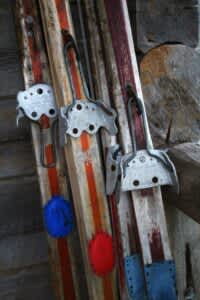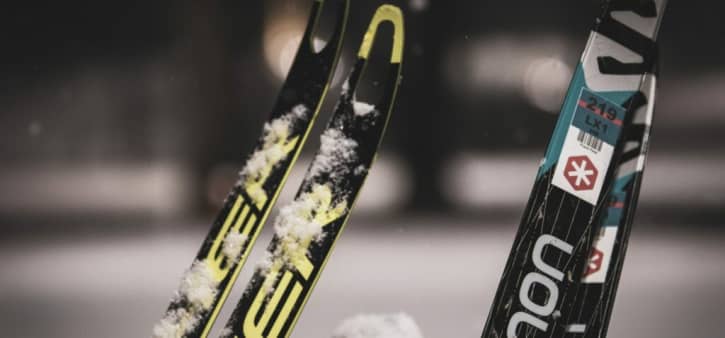Skiing is an exhilarating sport, and maintaining your equipment is essential for a smooth and enjoyable experience on the slopes. Ski waxing plays a crucial role in enhancing the performance and longevity of your skis. In this guide, we’ll explore the importance of ski waxing, the different types of waxes available, and how you can wax your skis at home.
Contents
Is Ski Wax Necessary?
Ski waxing is not a common practice, as perhaps only 3-4% of skiers and snowboarders wax their gear. This is a terrible mistake because waxing gives the bases more durability and speed, and it makes them easier to turn.
But more importantly, modern skis are designed with polyethylene bases (p-tex) which is a plastic that needs waxing on a regular basis. These bases normally absorb wax, but they can dry out by the following factors:
- Not waxing the p-tex bases regularly
- The base gets abraded by the snow’s high friction
- The bases get overheated by terrible stone grinding
- Using extremely high speed and pressure when the skier is roto-brushing
- Inadequate use of a wax iron
- Using an uncalibrated wax iron
- Overheating the base
Types of Ski Wax
The wax that you use depends on where you’re going to ski. There are waxes for people who would rather wax their skis at home, and there are waxes that experienced skiers use right before a competition which they can apply when they’re on the slopes.
Here is an overview to help you understand the types of wax as a beginner:
Ski Wax Temperature
- All-Temperature Ski & Snowboard Wax: This universal wax is ideal for any temperature and outside conditions. If you are a skier who likes to ride in different temperatures or areas, this kind of wax is an excellent choice. It can also be useful if you don’t wax your skis regularly, since it will last longer than temperature-specific wax.
- Temperature-Specific Ski & Snowboard Waxes: Snow’s temperature and moisture levels can change depending on the geographical area where you’re riding. Thus, there are waxes designed to work under a certain temperature range which improves the skiing performance. For example, pink waxes should be used in 34°F to 25°F (1°C to -4°C) temperatures, while violet waxes should be used in 28°F to 18°F (-2°C to -8°C) temperatures.
The temperature ranges can overlap, and you can mix two waxes. Just be aware of the outside temperature that day that you’re skiing. If you aren’t sure about the temperature, always go with a colder temperature wax. Cooler waxes usually give better results as opposed to using a warmer wax on a colder outside temperature.
Choosing Eco-Friendly Ski Wax
- Fluorocarbon Ski & Snowboard Waxes: Before 2019, waxes specially made for competitions contained perfluorocarbons (PFC’s) as a way of making the skis faster. But it was shown that these chemical additives are detrimental for the skier’s health because they can stay in the human body for a long time. Also, this product isn’t eco-friendly and biodegradable. For these reasons, PFC’s production in ski wax was banned by the FIS (International Ski Federation) and most governments around the world. By 2021, all commercial waxes contain hydrocarbons or they’re plant-based.
Green & Environmentally Friendly Ski & Snowboard Waxes: If you’re looking for more biodegradable products, there are many companies that offer eco-friendly waxes nowadays. For example, Mountainflow Eco-wax (ad) produces plant-based waxes and offers free shipping in the US. Similarly, Green Ice Wax offers products with alternatives to fluorocarbons focused on improving the athletes performance during a race.
Waxing Your Skis: DIY vs. Professional
You have two options when it comes to waxing your skis: either visit a ski tuning shop or do it yourself at home.
There are companies that offer ski tuning which consists of a series of processes to maintain your equipment. You leave your skis for a few days at the tune shop and they give you your skis back once they are waxed and tuned. For example, Denver Sports Lab offers a basic wax, edge sharpen, ski base grind or stone grind.
If you’re more of a DIYer, you can wax your skis on your own. You don’t need to be an expert to do it, and it will probably be cheaper for you. Plus, you will become more familiar with your equipment.
How Often Should You Wax Your Skis?
You should wax your skis or snowboard every 4 to 6 days if you ski frequently. Also, if you wax your equipment at home, you will be ironing about 4 bars or a kilo of wax every ski season.
There are other tips to maintain your skis or snowboard:
- After skiing, always dry your equipment, which will prevent your skis and snowboard from becoming rusty and corroded.
- Maintain the edges of your equipment with a diamond file every day spent skiing.
- If you have bought new skis, you should do a full base grind every 5 to 8 days after your purchase. This will allow the epoxy to settle on the new pair of skis. This process can only be done six times maximum during the skis’ lifespan and needs to be assessed by a professional.
- Flat the base of your skis to improve the control over your edges.
- Wax your skis after the season to prevent oxidation.
How to Wax Your Skis at Home: A Step-by-Step Guide
First, take a look at a good demonstration of ski waxing like this one from REI:
So here is what you will need:
- Your preferred wax
- A waxing iron
- A plastic Wax Scraper
- Waxing Brushes
- A work bench, vices or a waxing platform
- Rubber bands to hold the ski brakes
Before you start, retract your skis’ brakes, if they have them. Put a resistant rubber band around the arms of the brakes and over the heel. Therefore, the brakes will be held in the ski position.
Use an adequate vise that locks the skis, keeps them in place, and supports the tips and tails. This can also be achieved with wood blocks that can support these parts. Protect and cover the floor too because you can drip some wax during the process.
Once you’ve secured the skis to your bench by clamping or bracing them, you can start putting wax on the skis. The iron has to be upright with the point down. Press the wax against the iron and then move it on top of the surface. The wax will start to melt and this will leave a slight stream on top of the skis.
Then with your iron, spread the wax evenly over the ski’s base. In order to prevent overheating the base, you should move the iron 2 to 3 inches per second. Don’t add too much wax to the base — less is more. And remember not to touch the hot base or the wax.
Now it’s time to let the wax cool. Leave your skis at room temperature until they’re entirely cool. It may take a little more than 30 minutes, so check if they need more time to cool off. Finally, you can scrap and brush your skis.
Ski Wax Guide Conclusion
Why wax skis? They will move better and last longer. Regular ski waxing will ensure your safety, improve your performance, and extend the lifespan of your skis.
What is ski wax temperature about? If you don’t want to wax as often, get universal (all temperature) wax. If you can do it more often, then waxing your skis with temperature-specific ski wax when the temperature changes will boost performance.
Either way, consider using eco-friendly waxes that are safe for both you and the environment.
Should I wax skis at home? If you are patient and have more time than money, yes you can. Or you can take your skis in and have a technician do it for you.
Whether you choose to wax your skis at home or seek professional services, proper maintenance will ensure that you make the most of your time on the slopes. Happy skiing!











